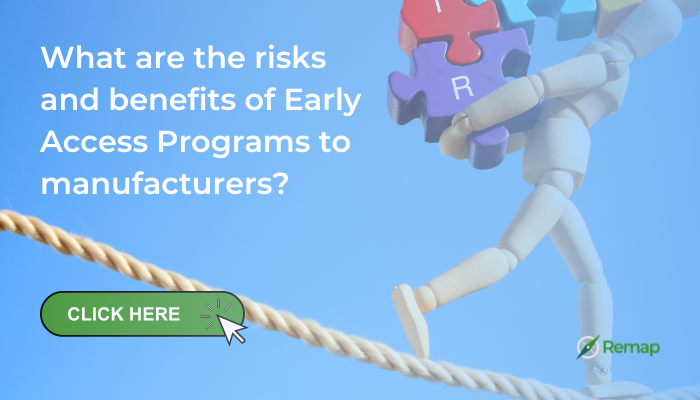Introduction
For patients with life threatening or seriously debilitating conditions, some countries have schemes which allow patients to have access to the medicine prior to it securing marketing authorisation approval. These schemes are called Early Access Programs (EAPs). There are many examples of EAPs from the early access to medicines scheme (EAMS) in the UK to the special access scheme (SAS) in Australia to the Emergency Access Program (EAP) in South Africa.
For the patients and healthcare systems there are clear advantages for having EAPs in place; those with life threatening conditions could be rewarded with an extension of their life and those with other serious conditions could improve their outcomes and quality of life. However, for the drug manufacturers, though there are a host of potential benefits, the risk of entering EAPs must also be considered.
Benefits of EAPs to Manufacturers
First let’s take a look at the potential benefits of joining an EAP for a manufacturer:
- Additional data collection: EAPs allow for real-world data to be collected on the manufacturers product which may strengthen the Health Technology Assessment (HTA) submission.
- Note: Some EAPS like Germany’s Arzneimittel-Härtefall-Verordnung (AMHV) does not allow any data collected to be used as part of the submission.1
- Faster route to market: Manufacturers can potentially bring a product to market faster, as it may allow for expedited regulatory approval compared to traditional routes. Some countries, like the UK, also make products in EAPs a priority for HTA assessment.2
- Smoother route to market: Healthcare systems, healthcare professionals and patients will already be familiar with your product and how it will work in practice.
- Early revenue: Manufacturers can start generating revenue from a product before it is fully approved for sale.
- Note: this is not a benefit in all countries and in fact most do not offer reimbursement for products in EAPs. The exceptions in Europe are France’s Early Access Authorisation (AAP) and Italy’s 648 where in both cases free pricing may be set and products reimbursed.3
- Reputational benefits: By making innovative medicines available to patients in need, companies can enhance their reputation and demonstrate their commitment to patient care.
Risks of EAPs to Manufacturers
However, along with the hosts of potential benefits described above, there are also some risks which manufacturers must weigh up when they are considering entering an EAP.
Limited to no revenue collection during the EAP
For most EAPs manufacturers will be expected to provide the product free of charge until a final decision about reimbursement is made and therefore comes at a cost to the manufacturer. In the case of the EAP in Belgium, if reimbursement is not agreed upon, the manufacturer must still provide the product free of charge to patients who were receiving it under the EAP. This lack of funding may be an especially prominent barrier for smaller companies. Even in those EAP agreements where free pricing is allowed such as the AAP in France, if the negotiated price is lower than the price set at free pricing, the manufacturer is required to pay back the difference.
Reputational risks
Although initially there may be benefits of an EAP on reputation, access to a product prior to rigorous analysis of its clinical and safety profile may lead to liability and reputation harm if the drug causes harm to patients or fails to meet expectations.
Increased administration
An increase in administration, and so a diversion of resources may be required to set up EAPs. Some EAPs such as Italy’s and France’s compassionate use programme are for identified patients only, this means that there will be paperwork to be completed on the side of the prescriber and manufacturer for each patient. Even in schemes that allow access for groups of patients, the process to enter these schemes may still be time intensive and costly. For example, the UK’s EAMS manufacturers must first apply for promising innovative medicine (PIM) designation before attending meetings with the MHRA and submitting a dossier in a process costing ~£30,000 and requiring significant resources to pull the application together.2
Conclusion
Additional data collection and the exposure of having a product in an EAP may be a large benefit for the submission and uptake of a product to the manufacturer. However, some EAPs may require substantial resource allocation to be set up and maintained and come with additional risks. Manufacturers must weigh up the risks and benefits for their product and for each EAP to determine if there will be a good chance of an overall net benefit. As the conditions of EAPs vary from market to market, manufacturers may choose to subscribe to some and not others due to the perceived risks or benefits of the scheme, or the product’s potential, or current disease area landscape in the market.
Sources:
1. Comparing and contrasting early access opportunities across the EU4 and the UK. Remap Consulting. https://www.ispor.org/heor-resources/presentations-database/presentation/euro2022-3567/119225. Accessed on 7th February 2023
2. What have we learned from the UK EAMS Process? Remap Consulting. https://remapconsulting.com/early-access/what-have-we-learned-from-the-uk-eams-process/ Accessed on 7th February 2023
